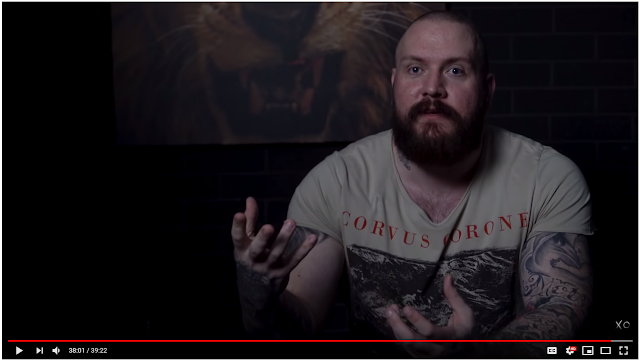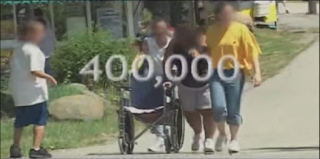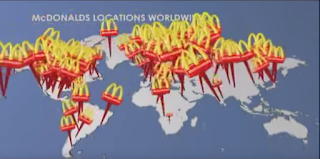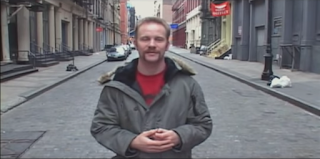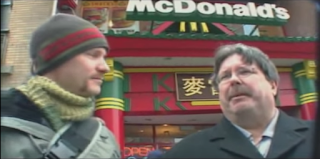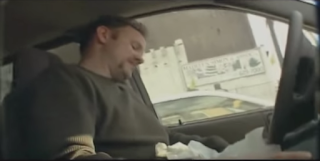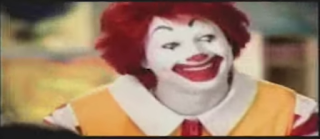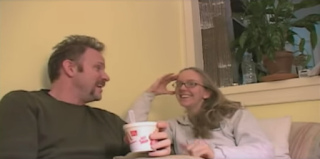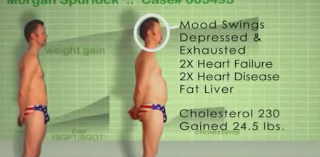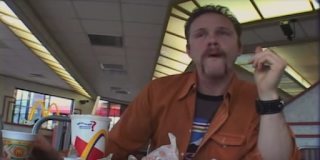This blog is going to focus on the directors of autobiographical documentaries. I want to understand why they made the decisions they did when creating their film. I will also compare their work to other productions they have directed to see if they continue with a specific visual style.
"WALK THE WALK" By Laurence McKenna
I want to research Laurence McKenna because he has created a number of documentaries for the YouTube platform which have been directed to create thought-provoking pieces which are accessible to a large audience. YouTube is a platform which has recently enabled people to have a voice and share stories which would not have been possible before the creation of social media sites. As it is now much easier to broadcast your documentary, it means more and more people are able to show their talents. The reason I chose to research Laurence, in particular, is because I have seen a few of his latest documentaries, and the way stories are told and filmed got me thinking of different techniques I could introduce into my own work.
I will focus on "WALK THE WALK" by the Youtube channel XO and which was directed my Laurence McKenna. This documentary has multiple narratives and through reading comments and forums people have both criticised and praised the use of multiple narratives. The documentary is about a fight between two boxers but also has a narrative about the host/presenter Brian. This second narrative focuses on Brian’s life up to the moment of achieving one of his dreams (commentating on a boxing match) which runs alongside the narrative of the preparation for the fight and the fight itself.
The first thing I noticed was that, as soon as the documentary starts, there is a flash forward to the very end of the documentary. This means the viewer already knows the result, which leaves less emphasis on what happens, but rather more on how it happened. This documentary was released several weeks after the actual fight meaning most people knew the outcome. Therefore, making the documentary and creating hype and build up to a result we all knew, would be pointless. We were actually going to use a fast forward to the race day in our own documentary, but to a slightly different effect. We do not want to show the result, instead of having a montage / high paced edit to excite the viewer, without giving away what happened. By doing this in the McKenna documentary, it immediately establishes a context for the viewer. It would be easy to start with Brian talking about his life but the viewer may not understand what the point of the documentary is. A flash forward is a guaranteed way of letting the viewer know where the focus is from the outset.
The use of archive footage is vital in grounding the documentary and telling the viewer why the subject matter is so important to the presenter. The particular use of this archive footage is to show the evolution of the presenter, from someone who struggled with who they were, to become the person they had always wanted to be. From this point onwards, we know that Brian has dedicated himself to achieving his dreams and learning from his past. It is important we get to see and hear Brian early in the film so that, as viewers, we are able to connect with him as a character. Later in the documentary, we are more easily able to understand his point of view. The opening monologue along with the archive footage enables the viewer to grasp an understanding of the presenter. As the director, Laurence would have to carefully pick out archive footage to match the story that is being told. While planning my own documentary, I am finding it hard to link the visuals to what I think is going to be said. This means you need to have an open mind as a director as something could be said in the documentary, and you need to then work with the editors and camera crew to make sure we get a cover shot or archive footage of that moment.
A directorial decision that is made early on in the McKenna documentary is that the presenter will be speaking to the person behind the camera, rather than at the camera directly. This is a way of making the conversation more natural and also breaks the 4th wall. It is a matter for debate which style is best for each documentary, but for this one, I think speaking to the person behind the camera eases the viewer into the story and it doesn't feel like the story is being told to them directly. When I watch this documentary I feel like I can relate to Brian and it almost feels like we have known each other our whole lives. That feeling is created by asking the presenter to "just talk" about ideas you want to highlight, instead of speaking to the camera with a script. Looking at this from a directors standpoint, I like the fact they have used multiple camera angles in this scene so it is not just the same shot for a long period. I feel that there could have been some movement because when you are filming in a style where the presenter is speaking to someone behind the camera, it makes two static cameras seem too staged. What is being used here is a very strange hybrid of a "staged" interview along with an "off the cuff” chat. It could have benefitted from some handheld shots, possibly cutaways of hands, eyes etc, to fully capture the cinematic style of breaking the fourth wall and showing the emotions and feelings that the presenter has. I like the final cut of the scene, but I find it hard to connect with Brian when he has been put into a location to share his thoughts. He normally speaks better when the topic is being discussed in an unstructured way at a random location or as a voiceover. However, I fully understand why the director has used a standard location for this element as it allows the viewer to understand what is going to be talked about once we come back to this room later on in the documentary. As soon as the viewer sees this room and these shots they know that a part of his life story is going to be told.
Something that Laurence does very well throughout this documentary is to use very intense cutaway shots. This is something I would have liked to have been in the PTC scene we have just talked about. The power of an extreme close up is that it gives the viewer a very distinct emotion when the shot is on screen. Whether this is a punch, a close up of the mic (see left) or someone's eyes, it evokes an emotion in the viewer and these shots are placed throughout meaning it keeps the viewer's attention. The use of extreme close-ups also enables the film to feel faster as when the whole shot is taken up by one thing it shows every single little movement. I think, however, that some of the extreme close-ups drag on for too long in this documentary which can have the reverse effect and slow it down. This could be because they did not have enough other cover shots or because they actually wanted that scene to be slow. Extreme close-ups are very dramatic and I feel they should be used sparingly so that it does not saturate the documentary. Too much of any shot makes it feel repetitive and boring. For our documentary, I want to start it with a flash forward and various extreme close-ups so the viewer feels the intensity and drama. But after the opening scene in my project, I want extreme close-ups to be used sparingly so that they are only used when an emotion needs to be shown. Overuse could cause the tone of the documentary to be wrong, which would be easy to do.
Very early on we also hear the voice of the man behind the camera, this fully breaks the 4th wall and enables the viewer to feel a part of the documentary. I think it was a good directorial decision by Laurence to let the camera operator have an active voice in the documentary as it enables the presenter to be more natural and have conversations that they would normally have, even without the camera. This scene is shot handheld, as is the majority of the documentary and that is something that Laurence as a director would have discussed right at the start. Handheld shots feel a lot more raw and natural, whereas tripod shots are much more staged and generally don't work for PTC's on the move in documentaries anyway. Being handheld also allows the camera to react to situations and when the documentary is focussed on an event which has sudden movement, being handheld is very important in enabling the viewer to see what has happened. This is one of the reasons I decided to focus on this documentary as it carries a lot of traits I will use in my project. Being handheld is going to be vital in enabling the viewer to see the situations for what they really are. There will be a few select scenes in my documentary where a tripod is used to create action by being very close to the subject matter, but mixed with the use of handheld cinematography it will create the style I want.
Throughout the documentary, Brian hardly ever looks directly at the camera. This would have been a directorial decision that was stuck to throughout the process. I like that the majority of the film is shot like this, but I feel that it would have been good to have a couple of scenes where he directly addressed the camera so that the viewer realises this is a serious topic/discussion and not quite as simple as it may seem from the documentary. I learned from this documentary that I want to shoot the majority of my documentary handheld, not speaking directly to the camera. But, I feel there will be a few scenes where a fixed camera would be used as I talk directly into the camera to reinforce a point or heighten the drama, almost as a way of unsettling the viewer.
Some parts of Laurence's directorial decisions would have happened on the spot. I have realised through my research into creating this style of documentary that you can never be completely sure of what is going to happen. So sometimes, as in this documentary, shots are created on the spot without any thought. In this scene, Brian is in the car singing which really humanises him. It would have probably been in Laurence's notes as a director to humanise Brian and make the viewer feel like he is just "one of us", but it is hard to script those scenes. In this case, it looks like the shot is filmed with an iPhone, but the sequence itself is not irrelevant. It shows Brian being natural and who he really is. It is inevitable that when you are aware of being filmed your reactions will be more self-conscious. Clips filmed without your knowledge allow the viewer to better judge your character.
One thing I have been interested in doing in my documentary from the start is showing some "behind the scenes" moments in the actual piece. This is also done in WALK THE WALK as is shown when they are micing up one of the fighters. This could have easily been removed, but I think Laurence as the director either needed this footage to bridge an OOV voice or wanted to include the process of creating a documentary in the actual documentary. The process of making a documentary often seems to feature in the end result. This is probably because unplanned events influence the way they are made. I personally really enjoy "behind the scenes" snippets because it makes the production feel a lot more authentic and shows the stages that the whole crew had to go through in creating it. It can also help transition from scene to scene. While planning my documentary I have struggled with transitions between certain scenes and this could be an option for a few of them. However, I think it is apparent that if you overuse a technique or style the impact is lost. By doing it sparingly the effect is greater.
Something I did not expect was the directorial decision to cut between self-shot footage and recorded footage from the event. At first, I was against the use of TV Coverage as I felt it lowered the overall quality of the video. It felt pretty clear that the TV Coverage broke up the story and took away from the cinematic style that the rest of the film was using. However, upon further reflection and watching the documentary multiple times, I see why Laurence chose this style. It enables the viewer to gain a wider perspective of what is happening in the fight, rather than using all self-shot footage from the camera operators making the documentary. It enables the documentary to change perspective and the viewer to see a completely unbiased view of events. I am still undecided whether this is the best idea for our documentary. There seems to be a camera crew at every event, but we are unsure if we can obtain the license to use it in the documentary and with 40 cars on the track, specific coverage for my team would be sparse. This may be a route we take after the filming is complete and we can see if we are allowed to use the TV coverage in our documentary.
In the middle of the fight there is an intense scene where Brian, the commentator is speaking really fast and hyping up a situation. The director must have talked with the editor in the edit as this sequence is very fast paced and starts to show shots from earlier on in the documentary. Mixing shots of waves and trains helped heighten the drama and these supposedly random images are actually from Brian's storytelling moments about his life earlier on in the documentary. This was a very clever directorial decision as the images of Brian's life are now mixing with the boxing fight. This is the moment in the story where the multiple narratives join together in one intense moment of commentary. The director would have worked closely with the editor to make sure this moment happened at the right part of the documentary. It was timed well and this is the first moment in the fight where Brian is speaking very passionately in the commentary. This is the moment where the viewer realises Brian has got his dream role of commentating and the passion really comes through in this intense scene.
There is an interesting use of masking in the edit. This would have been a directorial decision as once again by doing this it makes the scene more dramatic. It also enables the viewer to see the man behind the voice and his emotions and how invested he is in the fight. It would be hard to tell if Brian was just shouting or actually very passionate unless we have the shot of him. These are blended well together to create a sequence which ramps up the intensity and definitely makes the viewer more engaged in the fight.
Laurence does appear throughout as a voice and on screen. This shows the in-depth planning needed as a director to get the shots you want while being on screen. Our documentary will use the same technique so I will need to know when to pass over control. It is interesting to note that Laurence directed but also knew he would be on screen. His role was not as prominent as mine will be, but I feel I can learn a lesson about planning a scene when I will also be in it. I have already spoken to the group regarding the issue of directing and presenting. We have decided that I will direct, as usual, any scene where I am not on screen. For any sequence where I know I will be involved, I will send reference material to the group so they know how I want the scene to be shot. This will be vital to the success of our project because I won't be able to make the call when I am in front of the camera. This may be something Laurence struggled with as in his previous work he was always behind the camera. Once in front of the camera, he has to hand the responsibility to others.
What is also interesting is how Laurence decided there should be an L cut when it cuts back to a scene from earlier in the documentary. The interview from earlier says "the best thing that ever happened to me" while the next line of the commentary is "Joe is struggling a lot here". This would have been a directorial decision made after all the footage was together as that sequence is only powerful because the director knew the end result. The reason it was done like this was to show how much it meant to Joe, which hits hard when we realise he is badly losing the fight. When creating my project, I always need to be open to the script slightly changing and we could find a better way of telling the story. As with this example, we could notice something that was said early on the documentary that only gains significance once the story has played out. Laurence would have reviewed the footage once it was all complete and then made this decision. I found this interesting as I would have normally thought the director's job was pretty much done once filming is complete. However, after watching a lot of source material, I realise that the director plays a key role in decisions made in the edit.
I have mixed opinions about the ending. I like how he admits his mistakes as a commentator and talks about what he could do differently. He explains how he has changed because of the experience and all are things which should be included in an ending. I feel, however, that the scene is in the wrong location. I think to show the contrast in how far he has come, it should have been shot in Newcastle, his hometown, like the scenes of him remembering his past. It would have worked better there, to bring the story back to where it all started. That is something I want to do. While the main ending may be the race, I would like the closing thoughts to be at a motor racing track, as that fits with the purpose of my documentary.
I have certainly learned a lot about Laurence's directorial approach while looking into this documentary. I have since watched more videos that he directed on XO and they follow a similar style in terms of directorial approach (Very cinematic shots, "raw" moments and intense close-ups) But the editing is certainly different, many of the regular videos are faster paced and cut a lot quicker. This documentary certainly made me think that being a director can work even when you are on camera, but planning and a great crew are what make that possible. I feel the biggest thing learned from studying Laurence and this documentary is not to limit myself to the script. If you feel a scene will work a different way when it comes to the filming or edit, give it a go. The final script will most likely not look much like the original script. Sometimes a story can be told better once you know all the facts and have all the footage. I feel that if they had stuck to the original plan in every area the documentary could have lost the cinematic feel and quality. New ideas should always be considered, as it will make the documentary better by the end of the production.
CHRIS HOY - FROM VELODROME TO LE MANS (Directed by Christian Trumble)
Next, I wanted to focus on a motorsport specific autobiographical documentary to see if there were any special quirks when directing something very unique. The story is about Sir Chris Hoy's journey to race in the largest motor race in the world, the Le Mans 24 Hours.
This documentary has a very odd beginning, in my opinion. We start on the morning of the Le Mans 24 hour race and we see that Chris is ready for the race. While this does create some emphasis on the journey to the moment we are seeing, I would have preferred the documentary to start with a more personal look at his feelings. If you did not know who Chris Hoy was this opening would not get your attention, nor would it if you were not a motorsport fan. I am trying to understand the audience for this documentary as appears to be aimed at a wide audience, but a lot of the content is for motorsport fans. It is a weird hybrid and the introduction doesn't clearly set out what we are going to learn in this journey. What I have learned from this is, the introduction needs to be eye catching. We need stunning shots and intense music to draw the viewer in, especially if they are not a motorsport fan. The introduction to the Chris Hoy documentary didn't leave me with any sort of special feeling as the shots are generic and the soundtrack does not build up the event. Both this and my documentary are trying to build and "hype" up an event, so making it seem dramatic is key. Therefore, for our documentary, I want to have a more intense montage sequence opening our documentary, with punchy shots which are either close-ups or ultra close-ups, giving it a heart. I want the viewer to engage emotionally when watching the opening scene.
The story jumps around in this documentary, we start in "the future" then jump back to what we think is the start, then we jump back even further to gain a little more knowledge. The director seems to have over complicated the narrative to try and make it seem more interesting. However, I think by doing this (jumping back and forth) we start to lose any sort of interest in what may/may not happen. This is because we know he is going to race, we see him racing within the first few minutes. Saying this, I did like the fact that they went all the way back to the start and showed Chris's progression through motorsport and emphasise to the viewer that this is not a spur of the moment decision, he has been working on this for a while. The use of this archive footage shows Chris's passion for the sport and how he needed to find a replacement for competitive cycling. This insight also allows the general viewer to connect with Chris as his wife allows some glimpses into their life since Chris has started to compete in more motor races. Capturing these moments of honesty between characters is important in any documentary, however, it is even more important in an autobiographical documentary. This is where good teamwork between the director and the cinematographer will come into play. The cinematographer needs to predict what shots are going to be needed in the documentary to help create the tone. There is a certain amount a director can visualise, but sometimes things happen on the day that is unexpected. Test shoots with Cailan in our documentary will be vital as well as showing reference material about what broadcasts emotion well and what doesn't will be key in keeping our tone the same throughout.
As a director, I like the fact that the Chris Hoy documentary does not rely on stunning visuals to move the story along. They focus on getting moments that help improve the narrative and show the emotions of the characters. As previously mentioned, these shots will enable the viewer to connect with the characters and, if they do that, they will relate to the story. However, the documentary does not rely on handheld shots which simply capture the story, most scenes have a couple of establishing shots that introduce the location. The way that we can ensure we have a good mixture of reality and staged shots is to recce the track locations and know what will be accessible. I have already visualised some very cinematic shots to bridge scenes. An example is the Brands Hatch Iconography when driving into the track. Capture these moments and shots allow the documentary to be both natural and give the cinematographers some stylistic shots to attempt. A strong team connection will allow the emotion of the documentary to come through. This will be even more important because as the director and the subject matter, I will not be able to direct when I am in front of the camera.
One thing that I disliked about the Chris Hoy documentary was the use of a "Voice of God" rather than Chris narrating himself. I understand that he is more of a subject matter than a presenter, but I think his personality would have been able to shine through it he was doing the voice over and strengthen the connection between the viewer and him on screen. However, the Voice of God works well for delivering facts in a very intelligible way. The reason they did this could be because they wanted to ensure they had a neutral voice over to caveat anything that Chris said if needed. As a BBC 2 documentary, they try to remain as unbiased as possible, therefore that could be the reason why a Voice of God was used rather than the subject. If we had Chris voicing over as well, the documentary could become quite one-sided. For our documentary, we are aiming at a Channel 4 type audience, therefore I personally feel that if I voice over it will be better because we are not trying to remain unbiased and want to show the reality of the challenge I have set for myself. This does not have much to do with directing, but I do need to ensure that my commentary still fits the tone of the documentary and does not sound too informal.
Chris's personality definitely comes out as the documentary progresses. He has more time alone and we are able to see his quirks as a driver and human. I like that these are captured in a style not too dissimilar to a video diary or home video. These strengthen the connection between the viewer and Chris. These are handheld and not particularly amazing shots, but they are putting us in the moment and we feel a part of the journey when we are brought into his everyday life. An issue I am having when scripting and thinking how I am going to direct this is making sure I am natural in front of the camera. I know the shot I want as a director, and, as I am in the film, I need to be able to relinquish control when I am facing the camera. Camera tests of PTC's are going to be vital in enabling me to relax as a director on shoot days where I am involved. If I become involved it breaks the continuity and loses some of the honesty which moves the story along. Setting up too many scenes will also be counterproductive. As a director, I have already included an ideal camera angle and sequence, but it is up to the cinematographer to adjust to the situation and stray away from the storyboards when needed.
Throughout the Chris Hoy documentary, something the director does well is capturing the mini-stories of other "characters" in the project who we also see develop and change as the story goes on. This is very important in the overall narrative arc so that we see a progression in everyone, not just Chris. Chris's journey is only happening because of the people around him, and seeing how they react to him and learn with him is as interesting as his own story. As a director for our documentary, capturing these moments of actuality from other members of this project (like my teammate Sam) will be important to the tone of the project. The more external sources and voices we hear that are directly connected to the race/me, the better. They help tell my story better and we need to hear from them. I have written down in the script, some events that could take place while I am on track to evoke these emotions in other characters, but it will be down to the producer and camera operator to ensure these moments are captured in the ways I have planned. I am a big fan of including other contributors as it adds weight to the story, as long as they are still telling the story we want, we should include as many as possible!
In the Chris Hoy documentary, editing of the final race is actually really interesting. They are using a large mix of clips, some self-shot and some from the television crew there for the event. They are mixed together to heighten the drama and engage the viewer in the race. The director would have known that he would have had access to the clips otherwise it would have changed the way that he would have told the story. However, with access to this footage and commentary, I think it helps fill in the viewer without reverting back to the Voice of God every few minutes. Directing our project, I am unsure we will have access to any separate TV footage and as I am not notable in any way I doubt my name would be mentioned in the commentary. Therefore, we are going to station multiple cameras around the track and make our race sequence more of a montage. If we get access to any TV Coverage we may change this in the edit, but I personally feel we should try something unique and go for a very visually pleasing sequence with some bold shots. They would stand out and make it something different from the majority of motorsport documentaries.
As for shot types used in Chris Hoy's show, I liked the use of onboard cameras, they really put you in the position of him as a character in the show and allow us to see his emotions and movements while in the car. In our film, we will have more in-car space and need to take advantage of this. It will enable us to put 2 or even 3 cameras inside the car and take greater advantage of this viewing dimension. As a director, I will be sure to capitalise on the affordability of modern high quality action cameras to capture some vital moments in the car. As for outboard shots, the Chris Hoy show generally picks wider angles which are provided by the TV companies so that they show a broader perspective, but they do not create a great cinematic effect. I think, by stationing multiple cameras around the track, it will enable us to capture the shots we really want, rather than using footage shot for another means. I want to focus on close-ups and ultra close-ups in the race with possibly a mix to the pitlane every so often and maybe an ultra wide shot very occasionally to show scale, or for a brief pause. The intensity is important for me in the race scene, and in the Chris Hoy documentary, that intensity is lacking because of the shots they used.
The documentary had a great ending, however, one that really shows the emotion of the whole project. It may not have been apparent throughout the documentary, but we finally see Chris let go and release his emotions. It is powerful as we do not expect an Olympic gold medal winning cyclist to be in tears after finishing very low down in his class. The reason it is emotional is that the race had meant so much to him and had finally happened. This once again, is where spontaneity by the camera operator is key to capturing the shot. As I will be driving or at least, preoccupied, I need to trust Cailan to be ready to capture the moments of emotion, whether that be happiness, sadness or something else. As a director, I can be helpful in showing reference footage and possibly trying to film it myself, and create the cinematic effect I want to show in the ideal world. However, I am fully aware that we must not stage actuality or plan it too far otherwise it detracts from the story and is less meaningful.
Overall both documentaries have helped me understand my role as a director in different ways. Merging my role as director with the scriptwriter is not much of an issue, but learning to distance myself when being the presenter is key. Understanding how a scene could play out is important, but ensuring it isn't staged is more important, to ensure that we show a natural run of events. This research has enabled me to develop as a director and change some of my ideas and events to ensure they are capturing actuality. As a director I know I will be aware that the crew may not get the shot I initially planned, but it will be for the better if the shot it is one showing genuine emotion because that is what you want as a director of a project like this. You need the viewer to feel something.













